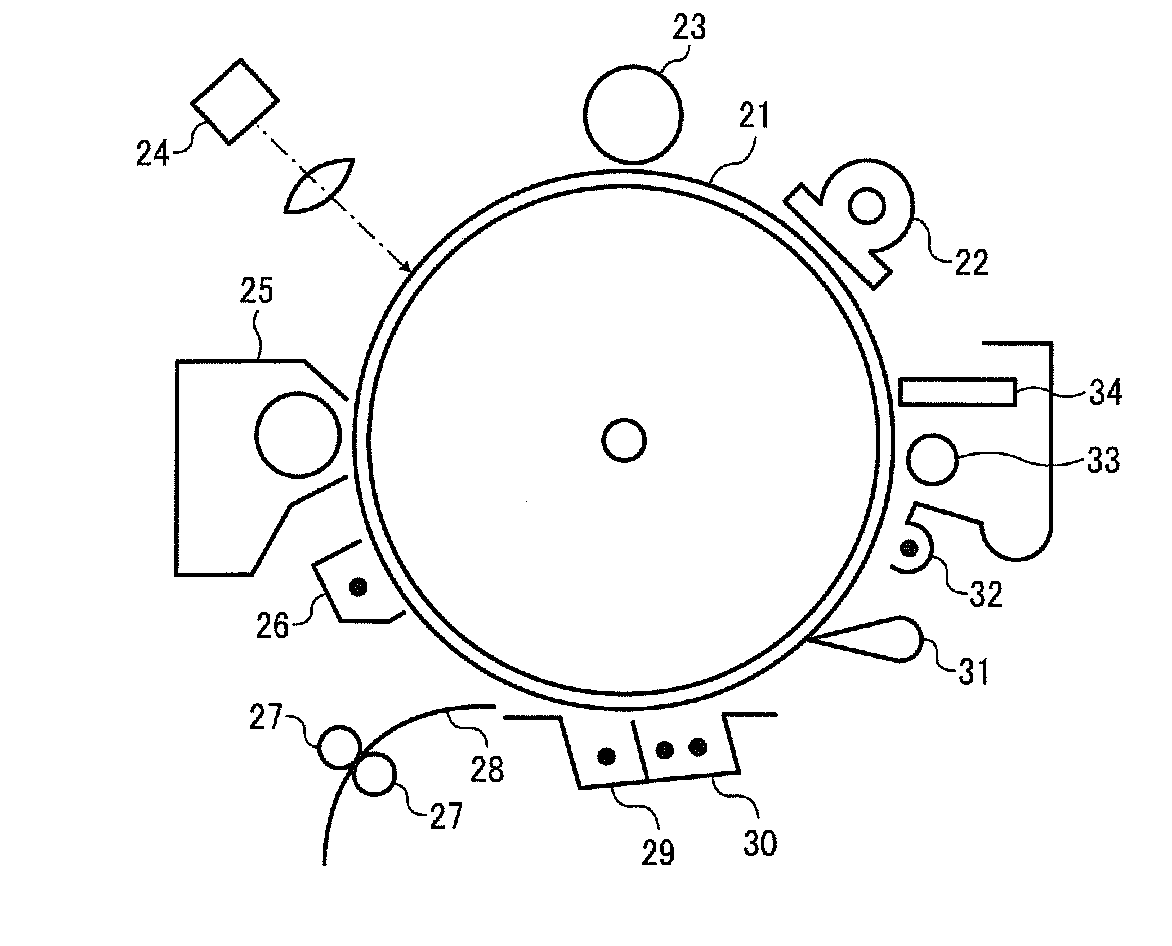Electrophotographic photoreceptor, and image forming apparatus and process cartridge therefor using the photoreceptor
a photoreceptor and photoreceptor technology, applied in the field ofelectrophotographic photoreceptors, can solve the problems of uneven dissolved cgl, background fouling, environmental stability problems of photoreceptors using titanylphthalocyanine, etc., and achieve the effects of preventing background fouling, good environmental stability, and high sensitivity of titanylphthalocyanin
- Summary
- Abstract
- Description
- Claims
- Application Information
AI Technical Summary
Benefits of technology
Problems solved by technology
Method used
Image
Examples
synthesis example 1
[0108]A pigment was prepared by the method disclosed in Example 1 of Japanese published unexamined application No. 2004-83859. Specifically, 292 parts of 1,3-diiminoisoindoline and 1,800 parts of sulfolane were mixed to prepare a mixture, and 204 parts of titanium tetrabutoxide was dropped into the mixture under a nitrogen gas flow. The mixture was then gradually heated to have a temperature of 180° C. and a reaction was performed for 5 hours at a temperature of from 170 to 180° C. while agitating. After the reaction, the reaction product was cooled, followed by filtering. The thus prepared wet cake was washed with chloroform until the cake colored blue. Then the cake was washed several times with methanol, followed by washing several times with hot water heated to 80° C. and drying to prepare a crude titanylphthalocyanine.
[0109]60 parts of the crude titanylphthalocyanine pigment was stirred mixed and dissolved in 1,000 parts of sulfonic acid having a concentration of 96%, and filte...
example 1
[0127]An undercoat layer coating liquid, a CGL coating liquid and CTL coating liquid having the following formulations were coated and dried in this order on an aluminum cylinder having a diameter of 100 mm and a length of 360 mm as a substrate to prepare a multilayer photoreceptor having an undercoat layer 3.5 μm thick, a CGL, and a CTL 23 μm thick.
[0128]The CGL had a thickness so as to have a light transmittance of 20% for light having a wavelength of 780 nm. The transmittance was measured by a marketed spectrophotometer UV-3100 from Shimadzu Corp. with light having a wavelength of 780 nm for an aluminium cylinder wounded with a polyethyleneterephthalate film and coated with the following CGL coating liquid, and a polyethyleneterephthalate film not coated with the CGL coating liquid. After each layer was coated and dried until it does not feel sticky with a finger, the undercoat layer, CGL and CTL were dried at 130° C. for 20 min, 135° C. for 40 min and 120° C. for 20 min to prepa...
example 2
[0129]The procedure for preparation of the electrophotographic photoreceptor 1 in Example 1 was repeated to prepare an electrophotographic photoreceptor 2 except for changing the formulation of the CGL coating liquid as follows.
(CGL Coating Liquid)Dispersion 210Isocyanate compound having the following formula (5)-10.14
PUM
| Property | Measurement | Unit |
|---|---|---|
| Length | aaaaa | aaaaa |
| Length | aaaaa | aaaaa |
| Length | aaaaa | aaaaa |
Abstract
Description
Claims
Application Information
 Login to View More
Login to View More - R&D
- Intellectual Property
- Life Sciences
- Materials
- Tech Scout
- Unparalleled Data Quality
- Higher Quality Content
- 60% Fewer Hallucinations
Browse by: Latest US Patents, China's latest patents, Technical Efficacy Thesaurus, Application Domain, Technology Topic, Popular Technical Reports.
© 2025 PatSnap. All rights reserved.Legal|Privacy policy|Modern Slavery Act Transparency Statement|Sitemap|About US| Contact US: help@patsnap.com



